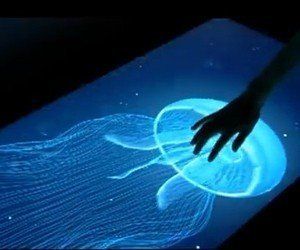Tactile Interface Technology for People with Vision Disabilities
Author: UC-Berkeley
Published: 2014/07/16 - Updated: 2024/09/10
Publication Details: Peer-Reviewed, Research, Study, Analysis
Category Topic: Disability Visual Aids - Academic Publications
Page Content: Synopsis - Introduction - Main
Synopsis: New research at UC Berkeley has found that people are better and faster at navigating tactile technology when using both hands and several fingers. As we move forward with integrating tactile feedback into displays, these technologies absolutely need to support multiple fingers.
Introduction
Imagine feeling a slimy jellyfish, a prickly cactus or map directions on your iPad mini Retina display, because that's where tactile technology is headed. But you'll need more than just an index finger to feel your way around.
Main Content
New research at UC Berkeley has found that people are better and faster at navigating tactile technology when using both hands and several fingers. Moreover, people with vision disabilities in the study outmaneuvered their sighted counterparts - especially when using both hands and several fingers - possibly because they've developed superior cognitive strategies for finding their way around.

Bottom line: Two hands are better than one in the brave new world of tactile or "haptic" technology, and the visually impaired can lead the way.
"Most sighted people will explore these types of displays with a single finger. But our research shows that this is a bad decision. No matter what the task, people perform better using multiple fingers and hands," said Valerie Morash, a doctoral student in psychology at UC Berkeley, and lead author of the study just published in the online issue of the journal, Perception.
"We can learn from blind people how to effectively use multiple fingers, and then teach these strategies to sighted individuals who have recently lost vision or are using tactile displays in high-stakes applications like controlling surgical robots," she added.
For decades, scientists have studied how receptors on the fingertips relay information to the brain.
Now, researchers at Disney and other media companies are implementing more tactile interfaces, which use vibrations, and electrostatic or magnetic feedback for users to find their way around, or experience how something feels.
In this latest study, Morash and fellow researchers at UC Berkeley and the Smith-Kettlewell Eye Research Institute in San Francisco tested 14 blind adults and 14 blindfolded sighted adults on several tasks using a tactile map. Using various hand and finger combinations, they were tasked with such challenges as finding a landmark or figuring out if a road looped around.
Overall, both blind and sighted participants performed better when using both hands and several fingers, although participants who are blind were, on average, 50 percent faster at completing the tasks, and even faster when they used both hands and all their fingers.
"As we move forward with integrating tactile feedback into displays, these technologies absolutely need to support multiple fingers," Morash said. "This will promote the best tactile performance in applications such as the remote control of robotics used in space and high-risk situations, among other things."
Related Information
- Advanced Touch-Feedback System Creates Consistent Tactile Experience on Screens: Consistent virtual haptic technology for virtual reality (VR) and augmented reality (AR) users.
- Tactile Defensiveness and the Autism Spectrum: Article examines tactile defensiveness, repetitive behaviors, obsessions, as well as routines regarding children with autism.
- Printing 3D Tactile Print Images for Blind: 3D printing process converts conventional paintings, drawings, collages or photographs into a 3D Tactile Fine Art Print.
- Tactile Lithophane Makes Scientific Data Accessible to Students With Blindness: Tactile learning device makes science accessible to students with blindness or low vision (BLV) opens possibility of transfer of scientific data or images for sighted students into functional formats for students with blindness.
- Sight Unseen: Tacticle Feedback Exhibit That Blind Can See: CMHR is the first museum in the world to showcase three-dimensional tactile fine art printing developed by 3DPhotoWorks.
- 3D Printing Objects and Books in Braille for People with Vision Disabilities: Convergence technology of 3D printing and 3D thermal reflow treatment to print braille books, braille picture books and materials with greater flexibility in color, height and size.
Attribution/Source(s): This peer reviewed publication was selected for publishing by the editors of Disabled World (DW) due to its relevance to the disability community. Originally authored by UC-Berkeley and published on 2014/07/16, this content may have been edited for style, clarity, or brevity.